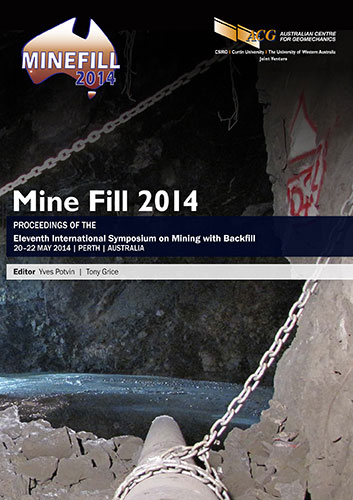Case study – a high strength paste aggregate backfill at Randgold’s Loulo mine in Mali

|
Authors: Lee, C; Gillot, P |
DOI https://doi.org/10.36487/ACG_rep/1404_17_Lee
Cite As:
Lee, C & Gillot, P 2014, 'Case study – a high strength paste aggregate backfill at Randgold’s Loulo mine in Mali', in Y Potvin & T Grice (eds), Mine Fill 2014: Proceedings of the Eleventh International Symposium on Mining with Backfill, Australian Centre for Geomechanics, Perth, pp. 231-242, https://doi.org/10.36487/ACG_rep/1404_17_Lee
Abstract:
The Loulo mine complex in Mali is composed of a number of open pits and underground mines which extract a cyanide leachable gold ore. Two of the mines within the complex (Yalea and Gara mines) have nearly exhausted their pit resource and are transitioning to underground mining. The mining method chosen is sublevel open stoping (SLOS) with cemented and uncemented backfill. A large portion of the SLOS stopes will be relatively wide (up to 15 m) and many of the stopes will be mined underhand with remote mucking under fill. To meet these requirements a high strength backfill is required which can reach strengths of 2.3 MPa and can be delivered underground at adequate flow rates to satisfy the mines’ cycle times. This paper addresses the design of the paste backfill plants that are currently being constructed at the Yalea and Gara sites and will be operational in early 2014. The paste plants incorporate a number of interesting features to meet each mine’s particular requirements while maximising the net present value (NPV) of the project. Specifically, the paper will illustrate a number of practical solutions to the challenges posed by tailings which exhibit poor strengths and poor dewatering properties. The solutions have resulted in a significant reduction in cement, and a projected yearly savings of over USD 20 m in cement costs. In addition, the paper describes the decoupling processes and the resulting flexibility that decoupling imparts on the paste fill operations. The remoteness of the site and the lack of mining support infrastructure nearby was a concern for Randgold and therefore the system was designed so that key processes were decoupled such that the system could still function for significant periods of time, even when major elements of the system were shutdown (such as tailings supply from the mill).
References:
Kuganathan, K & Sheppard, I 2001, ‘A non-segregating "rocky paste fill'' (RPF) produced by co-disposal of cemented de-slimed tailings slurry and graded rockfill’, in D Stone (ed.), Proceedings of the 7th International Symposium on Mining with Backfill, Society for Mining, Metallurgy, and Exploration, Englewood, pp. 27-41.
Luke, D & Rankine, R 2003, ‘Spatial variation in a paste–rock filled stope’, Proceedings of the International Seminar on Paste Thickened Tailings, Australian Centre for Geomechanics, Perth, Section 21.
© Copyright 2025, Australian Centre for Geomechanics (ACG), The University of Western Australia. All rights reserved.
View copyright/legal information
Please direct any queries or error reports to repository-acg@uwa.edu.au
View copyright/legal information
Please direct any queries or error reports to repository-acg@uwa.edu.au